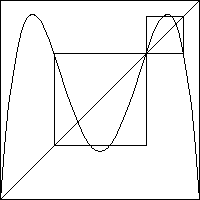Deterministic Chaos
6.P. Renormalization
One way to visually understand the
period-doubling sequence
is through a method called renormalization.
The sequence of pictures below shows graphs of L(x) and
of L2(x).
To the graphs of L2(x) are attached small squares
with corners at the nonzero fixed point of L(x) and with base length determined
by where a horizontal line from the fixed point next crosses the graph of
L2(x).
These are the trapping squares.
|
 |
 |
| Graphical iteration generates a chaotic sequence.
Click the picture to remove the iterates. |
What happens when the graph of L2(x) extends outside the
trapping squares? Recall if the graph of the function
extends outside the unit square, most points iterate away to -infinity. This cannot
happen here: even though the graph of L2(x) extends outside the trapping
square, it remains in the unit square. Rather than running away to -infinity, the
iterates simply exit the trapping squares for a while.
Click the picture to see the iterates. |
|
| Another view of the relation of the iterates of L2 and of L can be
seen by looking at the corresponding bifurcation diagrams. |
The complete cascade of behaviors of L(x) inside the
unit square is repeated by the portions of L2(x) in each of the two
trapping squares.
Similar results hold for all Ln(x). This explains the smaller
copies of the bifurcation diagram in the whole diagram.
Return to Deterministic Chaos.

